The new KyTopo map series, released as both a print-capable cartographic product and a cached web mapping service, has been lauded by William Andrews, the head of the Kentucky Geological Survey, Geologic Mapping Section, as “an excellent and intuitive portrayal of the Kentucky landscape.”
For many decades, the United States Geological Survey (USGS) topographic quadrangle map series was “THE” basis for mapping-related activity. The topo or quad maps framed our perception of the nation’s surface and the planimetric features situated upon it. A wide array of federal programs required that these USGS maps be utilized for submittals. Surveyors included them on plats as inset maps. Kentucky-specific statutes relied on these maps when defining features such as blue line streams [i.e., streams that appear as broken or solid blue lines on a USGS topographic map].
In the mid-1990s, USGS brought the topographic map into the digital age by releasing its digital raster graphic (DRG) product. These trusty basemaps were displayed in the background on the massive CRT monitors of that era, a mesmerizing sight as these raster images slowly rendered on screen.
GIS users quickly realized that the vector data they’d been creating and maintaining for years didn’t always line up perfectly with DRGs. As a result, agencies scrambled to adjust points, lines, and polygons.
Flash forward to December 2011 when the Kentucky Aerial Photography and Elevation Program (KYAPED)—or KyFromAbove—became a reality. With a focus on acquiring state-of-the-art lidar data and full-color, high-resolution aerial photography, KyFromAbove promised a new view of the Commonwealth’s surface with a level of detail and clarity that was previously unimaginable. Since then, and not surprisingly, one of the primary requests made by stakeholders in the GIS community has been for new lidar-derived contour lines.
In early 2017, as the impending reality of a statewide elevation model came into focus, the Kentucky Division of Geographic Information (DGI) began investigating the creation of a statewide contour dataset and associated cartographic products and web services. Consulting with the Commonwealth’s GIS gurus prompted DGI to think outside of the box.
Although it was painful at times, this process led to a plan to create a print-capable cartographic product and a cached web mapping service—the KyTopo map series. All derivative datasets, such as the contours, hillshade, and spot elevations, would be made available for download and published to the Kentucky Geography Network (KyGeoNet), Kentucky’s geospatial data clearinghouse.
After many months, two statewide contour datasets were created. One is somewhat aligned with the USGS 10-foot, 20-foot, and 40-foot contour intervals. The other is a statewide set of 5-foot contours that leverage scale threshold settings and group layer functionality to adjust dynamically to the viewer’s map scale. The entire contour creation process was driven by a routine developed by Dean J. Tyler of the USGS.
The KyTopo map series is Kentucky-specific in several ways. First, an entirely new set of landscape-oriented quadrangle tiles were developed. These new tiles align with the state’s existing 5k tiling scheme and are in Kentucky’s Single Zone coordinate system rather than the traditional USGS universal transverse Mercator (UTM)-based coordinate system.
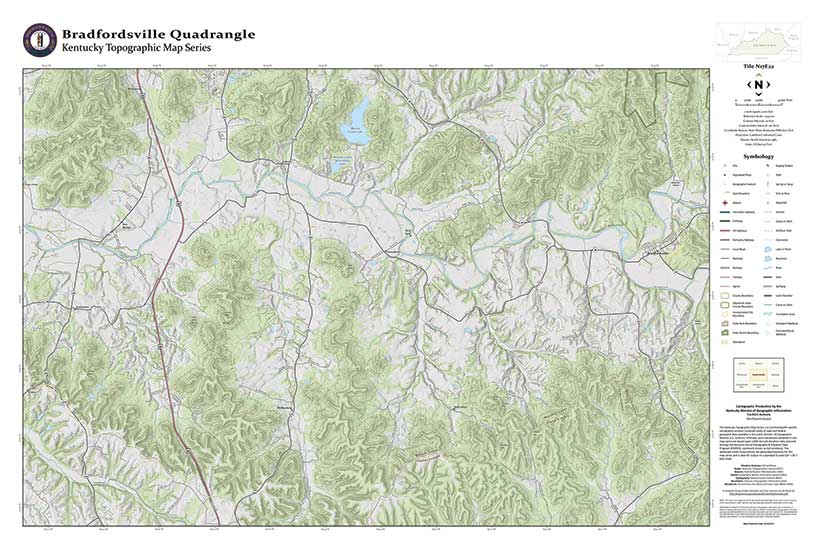
When printed, the map area is exactly 30 inches wide by 20 inches in height, which fits nicely on a standard Arch D (24 inches by 36 inches) sheet. The typical USGS quad scale of 1:24,000 (or 1 inch to 2,000 feet) has been maintained. Only 549 KyTopo map series tiles were required to map the state as compared to 779 USGS tiles. More important, the new Kentucky Single Zone tiles have square corners, unlike the UTM tiles.
The new map tiles needed names. In many instances, the names of the old USGS quads were adopted. However, sometimes this just didn’t make sense. DGI staff studied the methodology used by the USGS in naming maps and employed it. The USGS approach used the most prominent feature within a given tile as the name of that tile. That feature might be the largest city or the most centrally located place-name. In undeveloped areas, state parks, state forests, and natural features, such as streams, ridges, or lakes, were used.
Contour interval and index values were considered, and the standard USGS 10-, 20-, and 40-foot intervals were embraced along with the associated 40-, 100-, and 200-foot indexes. Different interval levels are necessary to accommodate the great variations in elevation change across the Commonwealth from east to west. Generally, KyTopo intervals in individual tiles align well with corresponding USGS tiles.
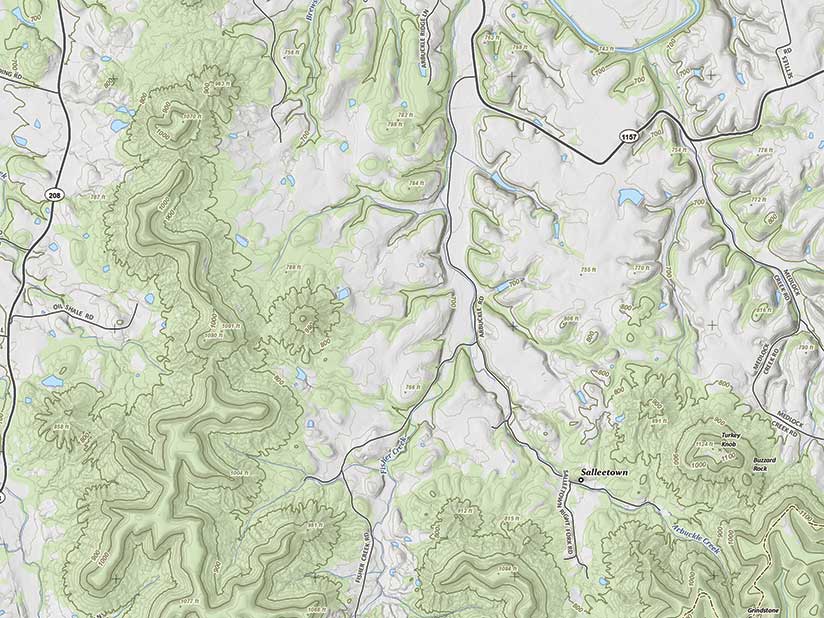
Weeks were spent gathering authoritative data for the project and fine-tuning the map layout and symbology. Much thought was put into determining which layers should be included and which should be omitted. As previously noted, all data is in the public domain and available. Much of it has been sourced directly from Kentucky state government and a variety of federal agencies. More than 80 percent of the layers had already been published to KyGeoNet. The entire map series and associated web mapping services will be updated annually to incorporate changes in the transportation network, forest cover, boundaries, and other features.
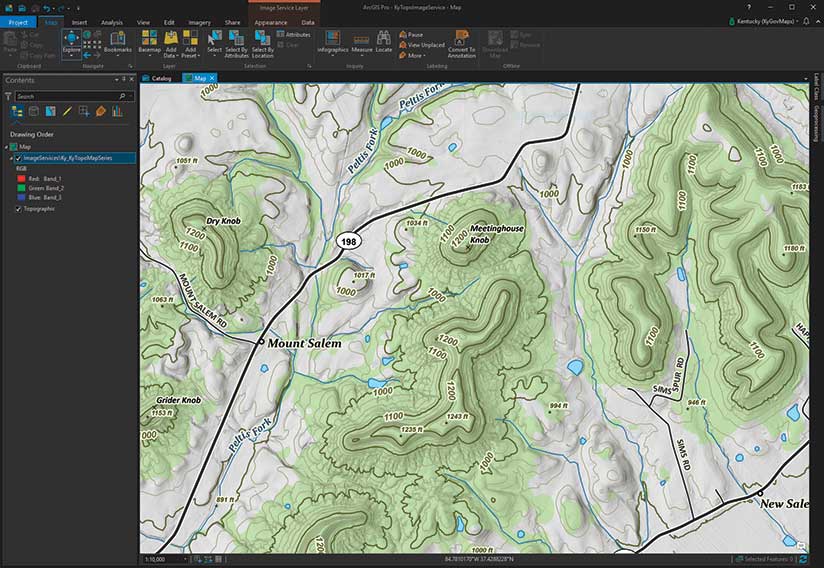
The production hardware environment for the KyTopo project consists of one enhanced 64-bit GIS workstation with 4 cores, 16 GB of RAM, and 1.5 TB of solid-state drive (SSD) storage running Windows 10 Enterprise. ArcGIS Desktop 10.5.1 is used for cartographic production. Its Data Driven Pages functionality makes it easy to create a series of layout pages from a single map document. In addition, Esri Production Mapping extension has proved useful for handling layout constraints and customized map elements.
The map output process is done through a series of Python scripts that take advantage of ArcGIS’s 64-bit background processing option to reduce output time for each map by 10 to 15 minutes. Initially, draft maps were output as 300 dpi PNG files for proofing and review. Feedback during the proofing process was used to further refine the map series.
Two types of maps have been produced for distribution: collared and uncollared. The collared version is a nongeoreferenced PNG file that includes all layout elements such as the legend, title, and any inset maps. The uncollared version is a GeoTIFF that is limited to the areal extent displayed in the data frame.
Significant effort was put into establishing an appropriate symbol set for this map series. DGI staff consulted the publication USGS Topographic Map Symbols. Some of its symbols were adopted, while others were adjusted to enhance readability. Once a symbol was selected, it was added to the KyTopo.style library using ArcGIS Style Manager. This tool effectively and efficiently manages symbology for large cartographic production efforts.
Typography received a tremendous amount of attention. Feature labels, titles, legends, and notes are just some of the text components of any cartographic product. Using the correct typeface for each element is critical when compiling a quality map. Discounting the importance of typography during cartographic production can lead to a map that is difficult to interpret or one that draws the user’s attention away from the subject.
Per the principles of thematic map design, serif typefaces were used for the map title, layout elements such as graticule labels, and hydrographic features. Sans serif typefaces were employed for road shields, road names, elevation features, and other selected layout elements. Maplex was enabled and used to handle the placement of feature labels. Hours were devoted to fine-tuning the Maplex labeling rules so more prominent features were placed prior to features of less importance.
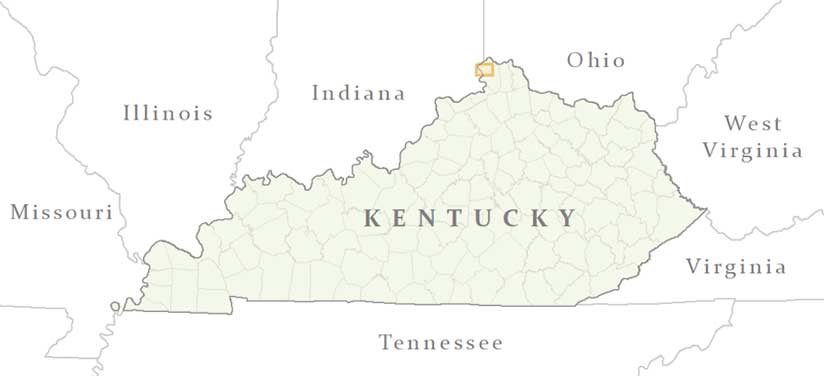
Every great map series includes both index and inset maps so users can see the location of each map tile in context. On each map tile, the KyTopo index map was located in the upper-right corner of the layout, highlighting that map tile in a statewide view. The inset map, positioned below the legend, shows the eight tiles that surround the subject map. Including these components on each map has proved quite helpful. Using a separate data frame for the index and inset maps with Data Driven Pages functionality allows this task to be automated.
One of the most frustrating layout elements was the legend. The legend created with the automated tools didn’t produce the most desirable results. For example, although the symbol for spot elevations appeared in the legend, the actual elevation value would not be placed beside it. Reluctantly, a cumbersome, partially manual process using Adobe Photoshop and Illustrator was adopted. The resultant legend is much nicer and better reflects the features in the map series.
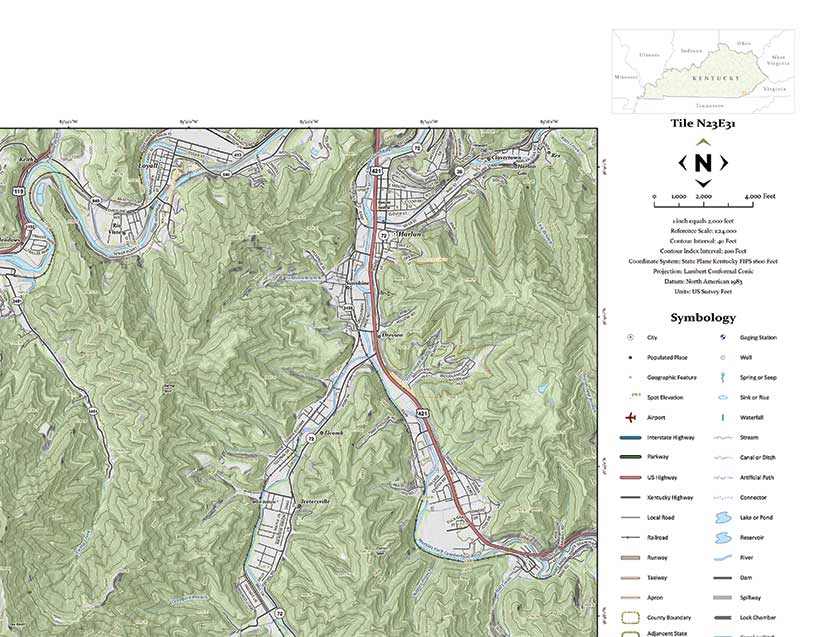
The first edition of the KyTopo map series is now complete. All PNG and GeoTIFF images can be download and are easily accessible via an ArcGIS Online web map. An image service in the Kentucky Single Zone, and a cached map service in web Mercator, are also in production. These services are being leveraged using ArcGIS Desktop, and a wide array of web mapping sites are adding the cached map service as an optional basemap.
The KyTopo map series has been well received. The map series has garnered numerous positive comments relating to its readability, its landscape layout, the use of a Kentucky-specific coordinate system, and its currency. Many are thrilled to know that it will be updated on a routine basis.
The contours used in the map series and the statewide 5-foot contour feature class are now in production in the Commonwealth’s enterprise geodatabases and are available for download from KyGeoNet. This great new resource is just one of the many valuable assets Kentucky realized through the KyFromAbove effort. “The look of the topo maps delivered by the KyTopo map service is stunning. KyTopo is perfect for many of our mobile applications; providing a clean, fast, and location-rich basemap,” according to David Carter, president of CDP Engineers. “The enhanced elevation data adds real value, especially in rural and rugged terrain settings. The KyTopo map service is a great addition to Kentucky’s public GIS resources.”
For more information, contact Kent Anness at kent.anness@ky.gov


